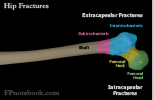II. Pathophysiology
- Often results from minimal to no injury
III. Risk Factors
IV. Diagnosis
- See Hip Fracture
- Images
V. Types: Garden Classification
- Non-displaced Fractures (20%)
- Type 1: Stress Fracture - Valgus impaction of head
- Type 2: Complete, non-displaced Fracture
- Displaced Fractures
- Type 3: Varus displacement of femoral head
- Type 4: Fracture fragments completely displaced
VI. Management
- See Hip Fracture
- Strongly consider regional Nerve Block in hip and Femur Fractures
- Fascia Iliaca Block or PENG Block in isolated Femoral Neck Fracture (without Coagulopathy or other contraindication)
- Non-displaced Fracture (Type 1 or 2)
- Bone impaction provides Fracture stability
- Bedrest results in 90% union
- Open reduction and Internal Fixation: 100% union
- Displaced Fracture (Type 3 or 4)
- Closed reduction and pinning
- Preferred in young patients to avoid hip arthroplasty
- Risk of Hip Avascular Necrosis
- Open reduction and Internal Fixation
- Lower morbidity (decreased blood loss and deep Wound Infection) when compared with arthroplasty
- Arthroplasty (acetabulum and femoral head replacement) or Hemiarthroplasty (femoral head replacement)
- Preferred option in older patients (over age 65 years)
- Lower reoperation rates
- Lower risk of avascular necrosis and nonunion
- Faster recovery
- References
- Closed reduction and pinning
VII. Complications
- Non-union
- Avascular Necrosis
- Types 3 and 4 confer 10% risk
-
Osteomyelitis or Septic Arthritis of the hip
- Reduced risk with perioperative Antibiotics
-
Pulmonary Embolism
- Leading cause of death at 7 days post-Fracture
VIII. References
- Gurr in Marx (2002) Rosen's Emergency Med, p. 655-60
- Schmidt (2002) Orthop Clin North Am 33(1):97-111 [PubMed]

